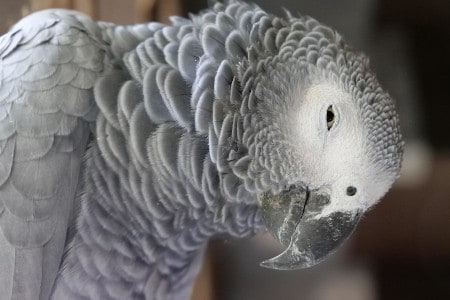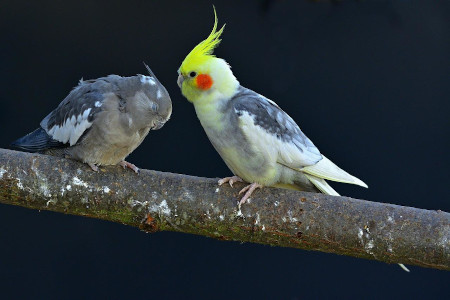Do parrots blink? It’s a question that has long been debated by bird enthusiasts and scientists alike.
Some say that parrots do not blink, while others claim that they do.
In this blog post, we will explore the answer to this question and discuss the various reasons why parrots might or might not blink.
Stay tuned for more information.
Do parrots blink?
Though they may not do it as frequently as humans, parrots do blink.
In fact, they have a third eyelid, called a nictitating membrane, that helps to keep their eyes lubricated and protected.
This membrane is semi-transparent, so it doesn’t completely obscure vision the way that blinking does.
When a parrot blinks, the nictitating membrane sweeps across the eye from front to back.
It’s thought that this helps to remove debris and keep the eye healthy.
In addition, the nictitating membrane can provide some protection in the event of an attack.
So, while parrots don’t blink as often as we do, they do have a way of keeping their eyes clean and safe.
Do parrots have eyelids?
When it comes to eyelids, parrots are a bit different than other animals.
Most animals have either an upper eyelid or a lower eyelid, but parrots have both.
In addition, they also have a nictating membrane, which is also known as a third eyelid.
This membrane helps to protect the eye and keep it moist. It also aids in vision, as it can help to filter out light and glare.
While the nictating membrane is not technically an eyelid, it serves a similar function.
So, do parrots have eyelids? Technically speaking, they have three.
You may also like: 7 Common Budgie Sleeping Positions and Their Meanings
Why do parrots blink so slowly?

When a parrot slowly blinks at you, it’s often taken as a sign of affection.
But why do these birds blink so slowly?
This is a sign of enjoyment. If one parrot sings to the other, or if the owner talks to them, they will stand still and blink slowly, or even close their eyes.
This shows that they build relationships with you, treating you as part of their flock.
A parrot blinking at you can mean that it is interested in what you are doing.
As a result, parrots developed the ability to control their eyelids, allowing them to blink slowly when they want to show trust or affection.
So next time your parrot gives you a long, slow blink, take it as a sign of love.
Scientists look at slow blinking from another perspective. They believe that this slow blinking helps parrots to stay aware of their surroundings.
By keeping their eyes open for long periods of time, they can keep a close watch for predators or other potential threats.
In addition, slow blinking allows parrots to take in more information about their surroundings, giving them a better chance of finding food or mates.
As a result, slow blinking is an adaptation that helps parrots to survive and thrive in the wild.
What are the functions of eyelids for parrots?
The function of eyelids for parrots is twofold: they help to protect the eye from debris and filter bright light.
First, the eyelids help to keep dust and other particles out of the eye, which can be particularly important in desert environments.
In addition, parrots close their eyelids when they are exposed to bright light.
By constantly cleaning the eyes, eyelids play an important role in maintaining the health of a parrot’s vision.
You may also like: Why Is My Budgie Sleeping So Much? Should I Be Worried
What are the purposes of the nictitating membrane?
The nictitating membrane is a translucent third eyelid that covers the eye from the inside corner and sweeps across the surface of the eyeball.
In parrots, this membrane serves several important purposes.
First, it helps to protect the delicate surface of the eye from debris and foreign objects.
Second, it acts as a natural lens cleaner, sweeping away any dirt or dust that has settled on the eye.
Finally, the nictitating membrane helps to keep the eye lubricated and moist, preventing dryness and irritation.
While this membrane is usually not visible when a bird is awake, it can be seen briefly when a bird blinks or yawns.
In some species of parrot, the nictitating membrane is also used to communicate certain emotions, such as excitement or fear.
As such, it plays an important role in avian social interactions.
Do parrots sleep with their eyes open?

Did you know that parrots also have some unusual sleeping habits? Unlike most animals, parrots do not have eyelids that close all the way.
As a result, they often sleep with their eyes open.
Some experts believe that this helps them to stay alert for predators, while others think that it may simply be a side effect of their anatomy.
Either way, it’s clear that parrots are not like other animals when it comes to sleep.
Next time you see a parrot taking a nap, don’t be surprised if its eyes are wide open.
Do Parrots Close Their Eyes?
Parrots seldom close their eyelids, even when they are sleeping.
While this may seem strange to us, there is a good reason for it.
In the wild, parrots are often targeted by predators.
By keeping their eyes open, they are able to spot potential threats and take action to defend themselves.
Additionally, their eyelids help to protect the fragile cornea, or innermost layer of the eye, from injury.
As a result, parrots have evolved to become vigilant creatures that rarely close their eyes.
You may also like: Can Cockatiels Sleep With Noise? Everything You Need To Know!
Do parrots squint?
Squint, also known as strabismus, is a condition in which the eyes are not properly aligned with each other.
While it’s hard to say for sure why parrots squint, there are a few possible explanations.
For one thing, parrots are very social creatures, and squinting may be a way of communicating with other members of their flock.
Additionally, squinting may help parrots to focus on objects more clearly.
Parrots have excellent eyesight, but they may squint in order to get a better look at something that interests them.
Finally, it’s possible that parrots squint simply because it feels good.
Whatever the reason, there’s no doubt that squinting is one of the many things that make parrots such fascinating creatures.
What Does It Mean If My Parrot Blinks More Than Usual?
If your parrot is blinking more than usual, it could be a sign of an underlying health condition.
Common eye problems in parrots include
- Mycobacteriosis
- Psittacosis
- Salmonellosis
- Vitamin A Deficiency
While some of these conditions can be treated, others may lead to blindness or even death.
If you notice that your parrot is blinking excessively, contact your veterinarian for an exam.
Early diagnosis and treatment can help improve your parrot’s chances for a full recovery.
Conclusion
Do parrots blink? Yes, they do!
In fact, blinking is an important part of avian anatomy and plays a vital role in a parrot’s overall health.
So, the next time you see a parrot blink, take a moment to appreciate all the amazing things that this simple act entails.
And if you notice your parrot blinking more than usual, don’t hesitate to contact your veterinarian for an exam. After all, it could be a sign of something serious.
